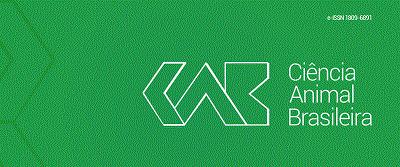Resumos
Objetivou-se avaliar o potencial de produção dos gases CH4 e CO2 in vitro dos ingredientes casca de soja, farelo de girassol, milho, polpa cítrica e silagem de milho. Quatro ovinos canulados no rúmen foram alimentados com dietas contendo os ingredientes avaliados na proporção volumoso:concentrado de 40:60. Os gases produzidos na incubação das amostras em líquido ruminal foram mensurados pela injeção em cromatógrafo gasoso equipado com detector de ionização de chama. O delineamento utilizado foi o inteiramente ao acaso em medidas repetidas no tempo, com três repetições para cada alimento avaliado em quatro diferentes períodos. Nas condições experimentais deste trabalho, foram verificados diferentes potenciais para produção de gases entre os ingredientes. A polpa cítrica foi o ingrediente de maior potencial de produção de CO2. A silagem de milho e casca de soja foram os ingredientes de maior potencial e a polpa cítrica e o farelo de girassol os de menor potencial para produção de CH4 em relação à matéria seca degradada, podendo ser considerados, entre os ingredientes avaliados, os de menores impactos ao ambiente.
Alimentos; CH4; CO2; degradação; ruminantes
This study aimed to evaluate the potential of CH4 and CO2 in vitro production of soybean hulls, sunflower meal, corn, citrus pulp and corn silage. Four rumen-cannulated sheep were fed diets containing the evaluated ingredients at 40:60 forage:concentrate ratio. The gases produced by samples incubation were measured by injection into a gas chromatograph equipped with flame ionization detector. The experimental design was completely randomized with repeated measures, with three replicates for each evaluated food at four different periods. Under the experimental conditions, we verified different potential gas production among the ingredients. The citrus pulp meal was the ingredient with the greatest potential for CO2production. Corn silage and soybean hulls showed the greatest potential while citrus pulp and sunflower meal showed the least potential for CH4 production, when expressed in mL/g of degraded dry matter; therefore, they can be considered, among the evaluated ingredients, those with the lowest environmental impact.
CH4; CO2; degradation; feed; ruminant
- ALUWONG, T.; WUYEP, P.A.; ALLAM, L. Livestock-environment interactions: Methane emissions from ruminants. African Journal of Biotechnology, v.10, n.8, p. 1265-1269, 2011.
- ASSOCIATION OF OFFICIAL ANALYTICAL CHEMISTS - AOAC. Official methods of analysis 16 ed., Washington D.C., 1995. 1094p.
- BACH, A.; YOON, I.K.; STERN, M.D.; JUNG, H.G.; CHESTER-JONES, H. Effects of type of carbohydrate supplementation to lush pasture on microbial fermentation in continuous culture. Journal of Dairy Science, v.82, n.1, p.153-160, 1999.
- BEAUCHEMIN, K.A.; KREUZER, M.; O'MARA, F.; MCALLISTER, T.A. Nutritional management for enteric methane abatement: A review. Australian Journal of Experimental Agriculture, v.48, p.21 - 27, 2008.
- GASTALDI, K.A. Produção «in vitro» de metano, dióxido de carbono e oxigênio utilizando liquido ruminal de bovinos alimentados com diferentes rações 2003.104 f. Tese (Doutorado em Zootecnia). Faculdade de Ciências Agrárias e Veterinárias, Universidade Estadual Paulista, Jaboticabal, 2003. Disponível em: http://www.athena.biblioteca.unesp.br/F/U1H19M59C3BGPLJKQ929V8YHQ1MRXE 9AJ9S4R6RIGHPK YR1THR-13568?func=short-0-b&set_number=000959&request=Gastaldi%2C
- GETACHEW, G.; DEPETERS, E.J.; ROBINSON, P.H.; FADEL, J.G. Use of an in vitro rumen gas production technique to evaluate microbial fermentation of ruminant feeds and its impact on fermentation products. Animal Feed Science and Technology, v.123, n.124, p.547 - 559. 2005.
- HALL, M.B. Neutral detergent-soluble carbohydrates nutritional relevance and analysis Florida: University of Florida, 2000. 42 p. (Bulletin, 339).
- HENDRIX, D.L. Rapid extration and analysis of nonstructural carboydrates in plant tissues. Crop Science, v.33, n.6, p.1306-1311, 1993.
- JOHNSON, K.A.; JOHNSON, D.E. Methane emissions from cattle. Journal of Animal Science, v. 73, n.8, p.2483-2492, 1995.
- LEE, H.J., LEE, S.C., KIM, J.D., OH, Y.G., KIM, B.K., KIM, C.W., KIM, K.J. Methane production potential of feed ingredients as measured by in vitro gas test. Asian-Australasian Journal of Animal Science, v.16, n.8, p.1143 - 1150. 2003.
- MILLER, G.L. Use of dinitrosalicylic acid reagent for determination of reducing sugar. Analytical Chemistry, v.31, n.3, p.426-428. 1959.
- MOSS, A. R.; JOUANY, J. P.; NEWBOLD, C. J. Methane production by ruminants: its contribution to global warming. Annales de Zootechnie, v.49, p.231-253, 2000.
- OFFNER, A.; BACH, A.; SAUVANT, D. Quantitative review of in situ starch degradation in the rumen. Animal Feed Science and Technology, v.106, p.81-93, 2003.
- PEREIRA, E.M.O.; EZEQUIEL, J.M.; BIAGIOLI, B.; FEITOSA, J. Determinação in vitro do potencial de produção de metano e dióxido de carbono de líquido ruminal proveniente de bovinos de diferentes categorias. Archivos Latinoamericano Produção Animal v.14, n.4, p.120-127. 2006.
- ROONEY, L.W.; PFLUGFELDER, R.L. Factors affecting starch digestibility with special emphasis on sorghum and corn. Journal of Animal Science, v.63, n.5, p.1607-1623, 1986.
- SANTOSO, B.; HARIADI, B.T. Evaluation of nutritive value and in vitro methane production of feedstuffs from agricultural and food industry by-products. Journal of the Indonesian Tropical Animal Agriculture, v.34, p.189-195, 2009.
- SAS. 2008. SAS/STAT 9.2 User's Guide SAS Institute Inc, Cary, NC.
- SEJIAN, V.; LAL, R.; LAKRITZ, J.; EZEJI, T. Measurement and prediction of enteric methane emission. International Journal Biometeorology, v.55, n.1, p.1-16, 2011.
- VAN SOEST, P.J.; ROBERTSON, J.P.; LEWIS, B.A. Methods for dietary fiber, neutral detergent fiber, and nonstarch polysaccharides in relation to animal nutrition. Journal of Dairy Science, v.74, n.10, p.3583-3597, 1991.
- VAN SOEST, P.J.; ROBERTSON, J.B. Analysis of forages and fibrous foods AS 613 Manual, Department of Animal Science, Cornell University, Ithaca, NY, 1985. 202p.
Datas de Publicação
-
Publicação nesta coleção
13 Jan 2014 -
Data do Fascículo
Dez 2013
Histórico
-
Recebido
18 Abr 2012 -
Aceito
09 Ago 2013

